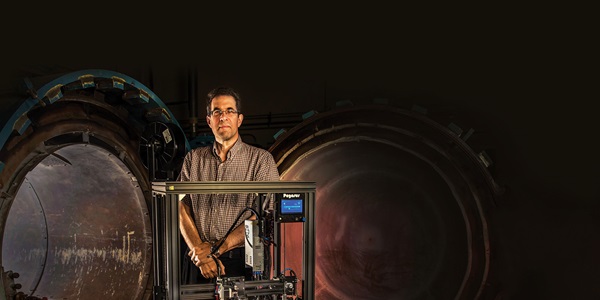Upgraded Radio Frequency Switch to Push Communications into the Future
Boosting innovation previously hampered by a 30+ year old RF switch design

By Tracy Staedter
What do smartphones, satellites, GPS and radar have in common? They all rely on radio waves to send and receive information. Radio frequency devices with miniaturized computer chips and other microelectronics inside have greatly improved their performance and cost.
But a meaningful upgrade to the component responsible for guiding and shaping the radio signal, called a radio frequency switch, has lagged for decades. Until now.
Dr. Robert Howell, a Northrop Grumman fellow and sector architect has invented a reliable, high-performance radio frequency switch. Unlike conventional radio frequency switches, it can handle a wide range of frequencies with minimal signal degradation, distortion or power dissipation.
Designed with an innovative 3D layered structure, the SLCFET (pronounced “Slick-fet”) — which stands for super lattice castellated field-effect transistor — will not only offer faster audio and video but also help usher in multifunction radio frequency platforms that transmit and receive signals for a host of technologies, from smartphone and internet communications to radar, directed energy and remote sensing.
"Wouldn't it be great to have one sensor that can do it all without compromising on performance?" asked Howell. "Instead of having many separate RF systems each requiring their own unique and expensive design implementations, we want hardware with enough operational flexibility that it can be repurposed into use for a multitude of different functions."
Back story: Resistance vs. Capacitance
Radio frequency switches are essential components of any electronic device designed to send and receive radio signals. Analogous to a light switch that turns off and on the electrical current that controls the lighting, a radio frequency switch blocks or passes the electrical current that is the RF signal. Doing so helps encode information into an RF signal, or on the receiving end of the chain, to decode that information.
Sending and receiving radio waves requires reliable blocking and unblocking electrical currents. That's done by controlling electrical properties called resistance and capacitance, these two properties are linked and have a tug-of-war effect on each other.
Designing a transistor to have low resistance increases its capacitance, while reducing its capacitance will proportionally increase its resistance. Lowering resistance allows electrons to flow more easily, which improves the signal strength. But it also raises capacitance, which lets radio signals leak out and limits the frequency of the signal that the switch can usefully control. An RF gadget can have hundreds of switches, each one impacting signal strength in a negative way, creating what's known as insertion loss.
Boosting innovation previously hampered by 30+ year old RF switch design
As radio frequency innovations push devices toward more complexity while needing to handle higher and more diverse radio frequencies, as with 5G, their system functionality has become more dependent on the performance of their underlying RF switches.
Unfortunately, since transistor-based radio frequency switches were first demonstrated in the 1980s, their performance has not significantly improved to this day because they haven't been able to get around the fundamental, tug-of-war relationship between resistance and capacitance, said Howell. However, the SLCFET does.
It's a semiconductor device fashioned with a structure so small, it can't be seen with the human eye. Called a super lattice, the structure is made from several alternating layers of aluminum gallium nitride and gallium nitride, each just tens of atoms thick. It has features common to all transistors: a source, a gate and drain. Electrons start at the source and flow through channels toward the gate, which opens or closes. In a component with a densely packed charge, a gate's shape, which resembles the crenellated rim of a castle tower, effectively pinches off each channel when necessary and opens again to allow electrons to pass to the drain.
Winner declared: SLCFET
Howell's design also does away with the tug-of-war issue. In lab experiments, he found that using the super lattice structure to stack additional channels where more electrons could flow lowered resistance but had no effect to capacitance - it remained constant. In other words, a lot of charge passed through a small volume, without the usual consequences for the radio signal.
"For the SLCFET device, you see lower insertion loss over a wide frequency range," says William Sweet, program manager at Northrop Grumman. "All of a sudden, you can put many systems under one hood and go between them seamlessly," he said.
Howell says he and his team are still working to improve the SLCFET, even as they make the first market-ready version available. They want it to handle higher powers, utilize less expensive packaging and add a moisture-protecting coating. They're also working to add an amplifier, which will allow required circuit components to be located on a single semiconductor chip. Circuits using SLCFET RF switches are in limited production now for various system prototype demonstrations, with full production of the SLCFET expected to start in about two to three years.
More innovation stories
Read all stories about advanced technology and innovation >>


